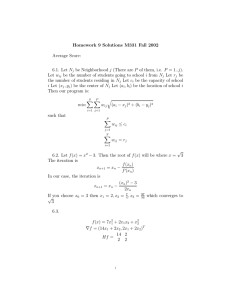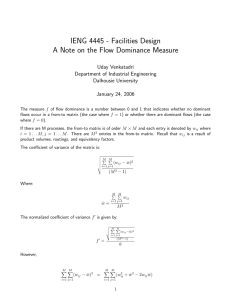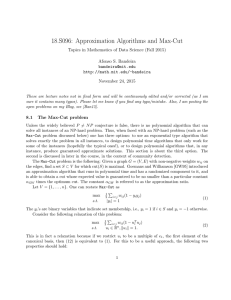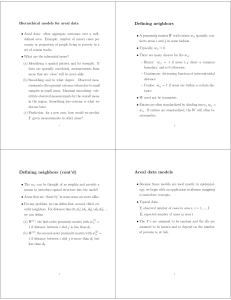8.3 A Sums-of-Squares interpretation
advertisement
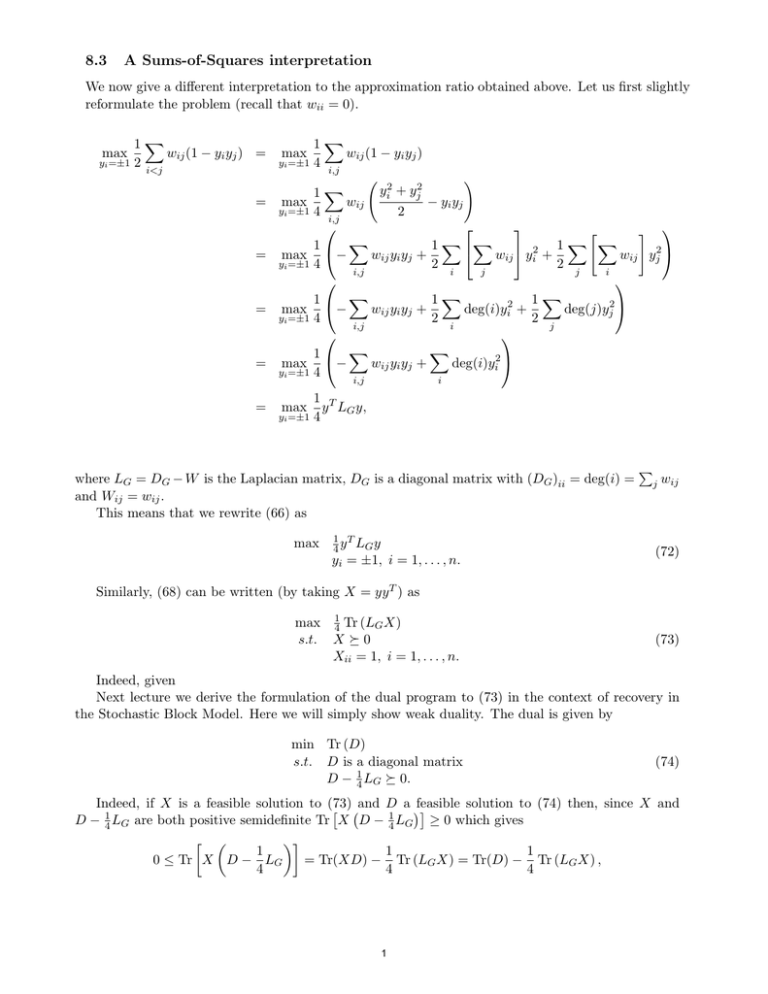
8.3
A Sums-of-Squares interpretation
We now give a different interpretation to the approximation ratio obtained above. Let us first slightly
reformulate the problem (recall that wii = 0).
1X
wij (1 − yi yj ) =
yi =±1 2
max
i<j
=
=
=
=
1X
wij (1 − yi yj )
yi =±1 4
max
i,j
!
yi2 + yj2
1X
max
wij
− yi yj
yi =±1 4
2
i,j
#
"
X X
1 X
1 X X
1
max
−
wij yi yj +
wij yi2 +
wij yj2
yi =±1 4
2
2
j
i
i,j
j
i
X
X
X
1
1
1
max −
wij yi yj +
deg(i)yi2 +
deg(j)yj2
yi =±1 4
2
2
i,j
i
j
X
X
1
max −
wij yi yj +
deg(i)yi2
yi =±1 4
i,j
=
max
yi =±1
i
1 T
y LG y ,
4
where LG = DG − W is the Laplacian matrix, DG is a diagonal matrix with (DG )ii = deg(i) =
and Wij = wij .
This means that we rewrite (66) as
max
1 T
4 y LG y
yi = ±1,
i = 1, . . . , n.
P
j
wij
(72)
Similarly, (68) can be written (by taking X = yy T ) as
max 41 Tr (LG X)
s.t. X 0
Xii = 1, i = 1, . . . , n.
(73)
Indeed, given
Next lecture we derive the formulation of the dual program to (73) in the context of recovery in
the Stochastic Block Model. Here we will simply show weak duality. The dual is given by
min Tr (D)
s.t. D is a diagonal matrix
D − 41 LG 0.
(74)
Indeed, if X is a feasible solution to (73)
a feasible solution to (74) then, since X and
and D
1
1
D − 4 LG are both positive semidefinite Tr X D − 4 LG ≥ 0 which gives
1
1
1
0 ≤ Tr X D − LG
= Tr(XD) − Tr (LG X) = Tr(D) − Tr (LG X) ,
4
4
4
1
since D is diagonal and Xii = 1. This shows weak duality, the fact that the value of (74) is larger
than the one of (73).
If certain conditions, the so called Slater conditions [VB04, VB96], are satisfied then the optimal
values of both programs are known to coincide, this is known as strong duality. In this case, the
Slater conditions ask whether there is a matrix strictly positive definite that is feasible for (73) and
the identity is such a matrix. This means that there exists D\ feasible for (74) such that
Tr(D\ ) = RMaxCut.
Hence, for any y ∈ Rn we have
1 T
y LG y = RMaxCut − y T
4
1
D − LG
4
\
T
+
n
X
Dii yi2 − 1 .
(75)
i=1
Note that (75) certifies that no cut of G is larger than RMaxCut. Indeed, if y ∈ {±1}2 then yi2 = 1
and so
T
1 T
1
\
T
RMaxCut − y LG y = y
D − LG
.
4
4
Since D\ − 14 LG 0, there exists V such that D\ − 14 LG = V V T with the columns of V denoted by
2
T
P
v1 , . . . , vn . This means that meaning that y T D\ − 14 LG = V T y = nk=1 (vkT y)2 . This means
that, for y ∈ {±1}2 ,
n
X
1 T
RMaxCut − y LG y =
(vkT y)2 .
4
k=1
1 T
4 y LG y
In other words, RMaxCut −
is, in the hypercube (y ∈ {±1}2 ) a sum-of-squares of degree 2.
This is known as a sum-of-squares certificate [BS14, Bar14, Par00, Las01, Sho87, Nes00]; indeed, if a
polynomial is a sum-of-squares naturally it is non-negative.
Note that, by definition, MaxCut − 41 y T LG y is always non-negative on the hypercube. This does
not mean, however, that it needs to be a sum-of-squares33 of degree 2.
(A Disclaimer: the next couple of paragraphs are a bit hand-wavy, they contain some of intuition
for the Sum-of-squares hierarchy but for details and actual formulations, please see the references.)
The remarkable fact is that, if one bounds the degree of the sum-of-squares certificate, it can be
found using Semidefinite programming [Par00, Las01]. In fact, SDPs (74) and (74) are finding the
smallest real number Λ such that Λ − 14 y T LG y is a sum-of-squares of degree 2 over the hypercube,
the dual SDP is finding a certificate as in (75) and the primal is constraining the moments of degree
2 of y of the form Xij = yi yj (see [Bar14] for some nice lecture notes on Sum-of-Squares, see also
Remark 8.4). This raises a natural question of whether, by allowing a sum-of-squares certificate of
degree 4 (which corresponds to another, larger, SDP that involves all monomials of degree ≤ 4 [Bar14])
one can improve the approximation of αGW to Max-Cut. Remarkably this is open.
Open Problem 8.2
1. What is the approximation ratio achieved by (or the integrality gap of ) the
Sum-of-squares degree 4 relaxation of the Max-Cut problem?
√
2. The relaxation described above (of degree 2) (74) is also known to produce a cut of 1 − O ( )
when a cut of 1 − exists. Can the degree 4 relaxation improve over this?
3. What about other (constant) degree relaxations?
33
This is related with Hilbert’s 17th problem [Sch12] and Stengle’s Positivstellensatz [Ste74]
2
References
[Bar14]
B. Barak. Sum of squares upper bounds, lower bounds, and open questions. Available
online at http: // www. boazbarak. org/ sos/ files/ all-notes. pdf , 2014.
[BS14]
B. Barak and D. Steurer. Sum-of-squares proofs and the quest toward optimal algorithms.
Survey, ICM 2014, 2014.
[Las01]
J. B. Lassere. Global optimization with polynomials and the problem of moments. SIAM
Journal on Optimization, 11(3):796–817, 2001.
[Nes00]
Y. Nesterov. Squared functional systems and optimization problems. High performance
optimization, 13(405-440), 2000.
P. A. Parrilo. Structured semidefinite programs and semialgebraic geometry methods in
robustness and optimization. PhD thesis, 2000.
[Par00]
[Sho87]
N. Shor. An approach to obtaining global extremums in polynomial mathematical programming problems. Cybernetics and Systems Analysis, 23(5):695–700, 1987.
[VB04]
L. Vanderberghe and S. Boyd. Convex Optimization. Cambridge University Press, 2004.
[VB96]
L. Vanderberghe and S. Boyd. Semidefinite programming. SIAM Review, 38:49–95, 1996.
3
MIT OpenCourseWare
http://ocw.mit.edu
18.S096 Topics in Mathematics of Data Science
Fall 2015
For information about citing these materials or our Terms of Use, visit: http://ocw.mit.edu/terms.
